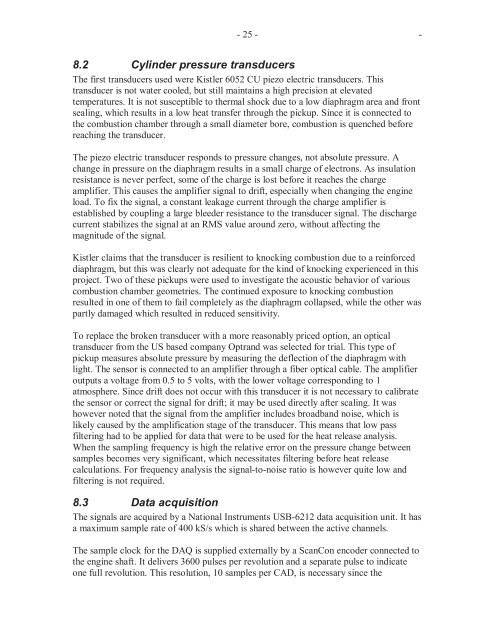Troels Dyhr Pedersen.indd - Solid Mechanics
Troels Dyhr Pedersen.indd - Solid Mechanics
Troels Dyhr Pedersen.indd - Solid Mechanics
You also want an ePaper? Increase the reach of your titles
YUMPU automatically turns print PDFs into web optimized ePapers that Google loves.
- 25 - -<br />
8.2 Cylinder pressure transducers<br />
The first transducers used were Kistler 6052 CU piezo electric transducers. This<br />
transducer is not water cooled, but still maintains a high precision at elevated<br />
temperatures. It is not susceptible to thermal shock due to a low diaphragm area and front<br />
sealing, which results in a low heat transfer through the pickup. Since it is connected to<br />
the combustion chamber through a small diameter bore, combustion is quenched before<br />
reaching the transducer.<br />
The piezo electric transducer responds to pressure changes, not absolute pressure. A<br />
change in pressure on the diaphragm results in a small charge of electrons. As insulation<br />
resistance is never perfect, some of the charge is lost before it reaches the charge<br />
amplifier. This causes the amplifier signal to drift, especially when changing the engine<br />
load. To fix the signal, a constant leakage current through the charge amplifier is<br />
established by coupling a large bleeder resistance to the transducer signal. The discharge<br />
current stabilizes the signal at an RMS value around zero, without affecting the<br />
magnitude of the signal.<br />
Kistler claims that the transducer is resilient to knocking combustion due to a reinforced<br />
diaphragm, but this was clearly not adequate for the kind of knocking experienced in this<br />
project. Two of these pickups were used to investigate the acoustic behavior of various<br />
combustion chamber geometries. The continued exposure to knocking combustion<br />
resulted in one of them to fail completely as the diaphragm collapsed, while the other was<br />
partly damaged which resulted in reduced sensitivity.<br />
To replace the broken transducer with a more reasonably priced option, an optical<br />
transducer from the US based company Optrand was selected for trial. This type of<br />
pickup measures absolute pressure by measuring the deflection of the diaphragm with<br />
light. The sensor is connected to an amplifier through a fiber optical cable. The amplifier<br />
outputs a voltage from 0.5 to 5 volts, with the lower voltage corresponding to 1<br />
atmosphere. Since drift does not occur with this transducer it is not necessary to calibrate<br />
the sensor or correct the signal for drift; it may be used directly after scaling. It was<br />
however noted that the signal from the amplifier includes broadband noise, which is<br />
likely caused by the amplification stage of the transducer. This means that low pass<br />
filtering had to be applied for data that were to be used for the heat release analysis.<br />
When the sampling frequency is high the relative error on the pressure change between<br />
samples becomes very significant, which necessitates filtering before heat release<br />
calculations. For frequency analysis the signal-to-noise ratio is however quite low and<br />
filtering is not required.<br />
8.3 Data acquisition<br />
The signals are acquired by a National Instruments USB-6212 data acquisition unit. It has<br />
a maximum sample rate of 400 kS/s which is shared between the active channels.<br />
The sample clock for the DAQ is supplied externally by a ScanCon encoder connected to<br />
the engine shaft. It delivers 3600 pulses per revolution and a separate pulse to indicate<br />
one full revolution. This resolution, 10 samples per CAD, is necessary since the

















